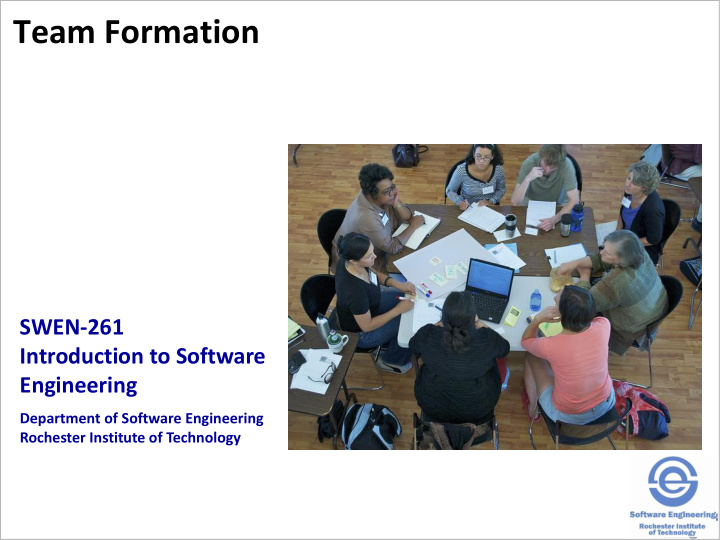



Team Formation SWEN-261 Introduction to Software Engineering Department of Software Engineering Rochester Institute of Technology
A group of people assigned to work together do not instantly turn into an effective team. Tuckman defined several stages that teams go through • Forming – initial team formation; team members behave in formal and reserved manner • Storming – team members position themselves against one another, often with confrontation • Norming – confrontation may continue, but the team tackles project issues • Performing – an effective and productive team is working together; trust between members is high • Adjourning – final teamwork prior to team disbanding 2
For your team to be effective, you should strive to support these characteristics. The bedrock of an effective team is trust in individual members, and individual members trusting the team. The team manages conflicts that occur and does not avoid or bury them. Team members have a full commitment to the team. Team members feel accountable to the team and the team holds individual members accountable. With the previous characteristics present, the team can focus on delivering results to the customer. 3
If conflict arises in your team, try some of these conflict resolution strategies. Conflict management styles span an Assertiveness to Cooperativeness range • Assertiveness is the degree to which you try to meet your own needs. • Cooperativeness is the degree to which you try to help others or the team meet their needs. Collaborative – often finds a new win-win solution Competitive – you better be right Accommodating – you lose to achieve a higher goal Avoiding – a solution to gain time or for low stakes Compromising – mutually acceptable solution 4
Your project grade is determined by the team's results adjusted by your individual contributions. Your team submits work for each of five sprints with a grade assigned for the team's results. Your individual contributions can modify that team grade either positively or negatively. • There is an audit trail of accountability in all of the team's activities. Planning (Trello board) Coding and documentation (GitHub repository) Engagement with team (Team Slack) • You must have an equal presence in team activities. • Your instructor will look in those areas. If you have little presence , you made no contributions . • Peer evaluations will also be strongly considered. 5
Agile teams are self-directed. Self-directed teams manage their own activities which requires team cohesion. Teams tend to be egalitarian in assigning task responsibilities. • There tend not to be fixed roles. • The team will use the varied and diverse skill set of its members to its best advantage. • The team is responsible for making sure that all tasks get covered. • Every team member is eager to pick up new tasks to help further the team's goals. • There is no individual ownership of artifacts particularly code. 6
Recommend
More recommend